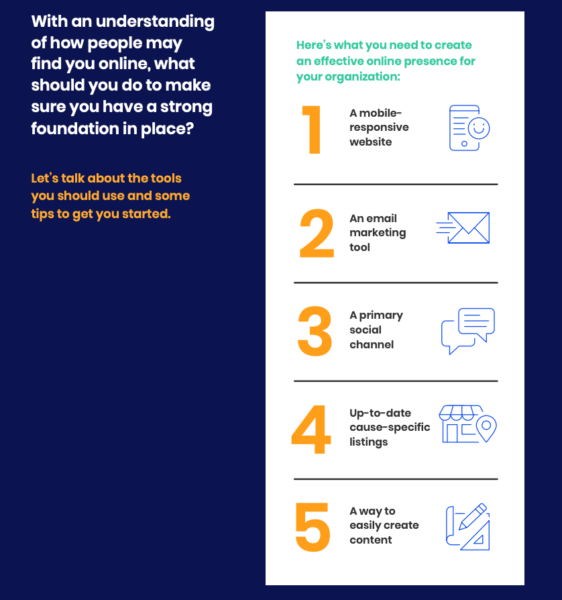
I recently got a call from the new part-time marketing manager of a community arts center. She told me she was willing to learn how to manage their nonprofit email marketing program but was concerned that there was more that she should be doing. “We send out emails and have a website,” she told me, “but I’m not sure we’re doing everything we can to let people know about our programs.”
Wouldn’t it be great to know exactly how you should be investing your marketing resources?
And what do we mean when we say “marketing”?
If you’ve struggled with these questions or felt overwhelmed juggling all of your nonprofit’s online marketing efforts, trust me – you are not alone.
Making sense of online marketing for nonprofits
In my experience, “marketing” is one of those words that gets tossed around quite a bit, yet I often suspect that people have different ideas of what it means to market their organizations.
Nonprofits have their own specific online marketing needs that differ from for-profit businesses. They also often have the additional challenge of limited time and resources, and an obligation to donors to make every marketing dollar count. It can be tough to know what to focus on first.
Inspired by the needs of their nonprofit customers, Constant Contact has rolled out the ultimate free guide to nonprofit marketing. The Download: Making Sense of Online Marketing details the must-knows of the entire nonprofit online marketing mix, including:
- How people find your organization online
- How to approach social media, email, and website content
- How to set yourself up for successful fundraising
- How online marketing can help your organization’s mission
In short, this comprehensive, step-by-step online marketing guide for nonprofits will take you from digital newbie to online marketing expert in no time.

But before you dive into the full guide, let me give you a quick overview of the basics of nonprofit marketing.
What do we mean by ‘marketing’?
There seem to be as many definitions of marketing as there are Google hits (more than 11 billion). In fact, I found 72 definitions of marketing in a single blog post! Entries range from business school expositions to an analogy that likens marketing to farming (marketing prepares an audience to receive a direct sales pitch, the way plowing prepares a field for planting). I actually kind of like that last one.
Anyway, as I read through the different takes on what it means to engage in marketing (no, I didn’t read all 11 billion, although at one point it felt like I did), three themes emerged: communication, calls to action, and relationship-building.
When a business engages in marketing, it communicates information about a product or service to people to get their attention and interest, with the goal of moving them closer to taking a particular action, such as buying a product or service. Most marketers are interested in building relationships with their audiences as well, because brand and product loyalty are key to a company’s sustainability.
What is nonprofit marketing?
Nonprofit marketing involves adapting business marketing concepts and strategies to promote the interests of a nonprofit organization. To market a nonprofit organization, you will need to communicate about the work you do to get people’s attention and to get them interested, with the goal of moving them to take a particular action as well as strengthening their relationship with your organization.
How is nonprofit marketing different from traditional business marketing?
Marketing a nonprofit organization is an awful lot like marketing a for-profit company. Except when it isn’t. I’ll explain.
Communication is the basis of marketing for both for-profit companies and nonprofit organizations, but each will be communicating different things. A for-profit business will point out how customers will benefit from buying its products or services. A nonprofit organization will want to highlight how its clients and the greater community benefit from its work.
For example, you represent a nonprofit that trains rescue animals to serve as therapy animals in a local nursing home. There are so many benefits! You are reducing the stray animal population. You are giving deserving animals a second chance at a good life with caring owners. You are providing much-needed companionship and joy to nursing home residents. You might even be contributing to outcomes such as improving nursing home residents’ participation in social activities or physical therapy.
Nonprofits’ calls to action will have some similarities to those of their for-profit neighbors. For example, a first call to action for a new potential supporter, much like a new potential customer, might be to invite them to follow your organization on social media and/or to join your email list.
Of course, the obvious call to action for a nonprofit is to ask for donations, but it would be a big mistake to limit yourself to this. An important part of relationship-building for a nonprofit involves calls to action that do not directly ask for money.
You do not want to be the nonprofit that only reaches out when they are looking for a handout. People want to feel like they are part of your good work, and this requires two-way communication.
An important part of relationship-building for a nonprofit involves calls to action that do not directly ask for money.
(Tweet this!)
How do you market a nonprofit organization in the digital age?
Chances are good that you have already been engaging in marketing for your nonprofit organization. Perhaps you set up a table at a local downtown street fair and handed out flyers about an upcoming program. Guess what? You were marketing your organization. Maybe you mailed a brochure or newsletter to all of the people who attended your events in the past. That’s more marketing!
What if I told you that with just a couple of digital marketing tools and a little bit of a learning curve you could boost your marketing reach with a lot less effort than it takes to set up that table at the street fair?
I am not suggesting that you give up entirely on your person-to-person marketing efforts. It is important for nonprofits to be visible in the community and to interact face-to-face.
What I am suggesting is that digital marketing tools can add rocket fuel to your on-the-ground efforts. The fact is that 90% of adults in the U.S. are using the internet.
And if you’re thinking that this doesn’t have any bearing on the life and work of a small nonprofit organization, think again: Blackbaud reports that 13.4% of total funds raised by organizations with budgets below $1 million came from online giving.
Strategic use of digital communications will boost your brand recognition in the community, while also helping you to reach way more potential supporters. With a few basic yet thoughtful strategies, you can make a real difference in your outreach results, which will ultimately contribute to your positive impact in the community.
As I mentioned before, your goal, whether at the street fair or online, is to encourage two-way communication. You want to be in conversation with your circle, and to make that circle grow. Put on your creative thinking cap and see what digital tools can do for you.
Here’s an example: Suppose you volunteer for an organization that regularly posts and emails requests for donated items to stock a thrift shop. Why not add some fun to the next drive by “styling” a few outfits from the donations, posting and emailing photos of them, and asking your audience to vote on their favorite “new” look? Require visitors to sign up for your email list in order to cast their vote. Set up an automated response to thank the list joiners with a coupon that they can use in your shop.
Of course, you’ll want to follow up and make a fuss over the “winning” looks, which is yet another opportunity to connect with your audience – and to communicate your organization’s mission and work.
How should my nonprofit begin marketing with digital tools?
Here are the basic digital tools that every nonprofit organization should – and very easily can – use:
- A good, mobile-friendly website
- A social media presence
- An email marketing program
Before you take the plunge into online marketing tools, however, I would like to recommend a few very important, non-technical steps:
Define your brand
Have a good handle on your mission and vision, both narratively and visually. Establish common language that can be used throughout your digital (and print!) media. The same goes for your logo, color schemes, and even typeface. When all of your marketing pieces align over time, people will have an easier time associating what they see with what you do.
Once narrative and style decisions are made, consider documenting them in a brief “style guide” to provide guidance to staff members or volunteers who might be producing marketing materials, from event invitations to meeting agendas.
No budget to hire a designer? Talented students from a local college or high school art department might be eager to help. In fact, why not ask a school’s faculty if they’d like to use your nonprofit branding needs as a class project? This, in itself, would make for a great social media story.
Have a plan
Keep it simple, and achievable. Decide what digital media tools and channels that you will use, and set a schedule for updating, posting, and emailing.
Think through how your digital tools will connect to and support each other. Your website should encourage email signups and social media following. Your social media profile should link back to your website and to your email sign-up page. Every email should include links to your website and to social media profiles.
Choose a few marketing metrics to follow. The easiest to follow are new email signups, email open and click rates, and website traffic. College marketing departments are full of tech-savvy students looking for meaningful volunteer opportunities that will also build their portfolios.
Commit to online marketing
Make sure there are at least two people at all times who are tasked with learning and maintaining your digital presence. Again, think about utilizing volunteers if you don’t have the resources to hire a marketing manager.
Once past the learning curve, digital tools are pretty easy to update; the bigger challenge is keeping your ear to the ground to pick up the latest news and accomplishments, so that they can be added to your website, or touted through email and social media. Make sure there is an open line of communication between the people running your organization’s communications and those executing the mission on the ground.
Marketing is essential to your nonprofit’s ability to fulfill its mission. Online tools offer enormous opportunities for telling your organization’s unique and compelling story, and for engaging people who are interested and who want to help. I hope you’ll give it a try!




